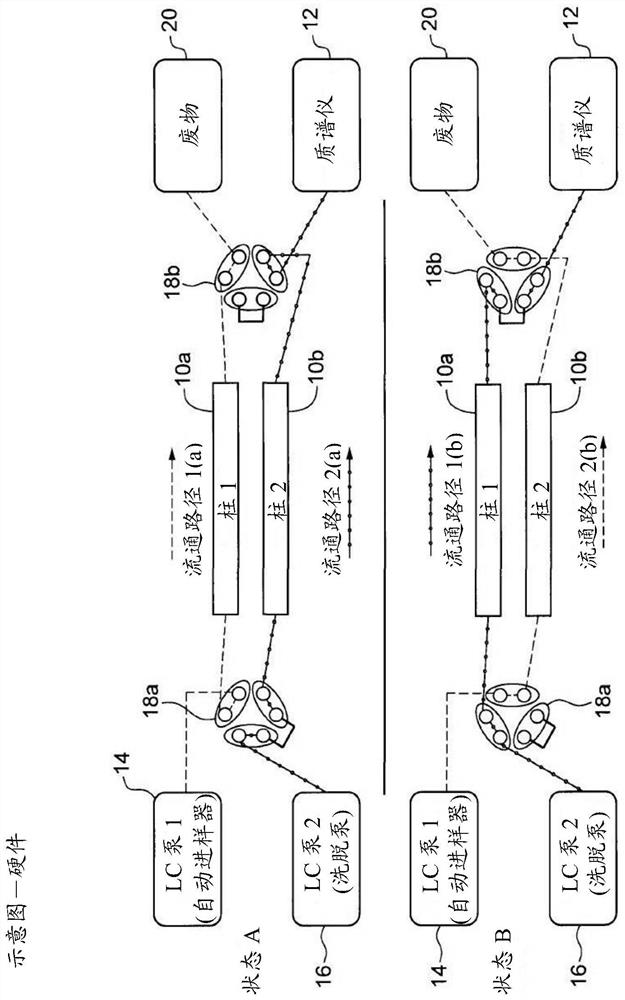Method for detecting urinary tract infections and sample analysis using liquid chromatography
A technology for sample analysis and urinary tract infection, applied in the field of clinical sample analysis, can solve the impractical problems of waiting for clinical results
- Summary
- Abstract
- Description
- Claims
- Application Information
AI Technical Summary
Problems solved by technology
Method used
Image
Examples
Embodiment IA
[0064] Example IA - Analysis of Urine Samples Using Isocratic Sequential Chromatography
[0065] Sequential isocratic chromatography was first optimized using unlabeled agmatine spiked into healthy urine control samples to construct a simulated UTI sample. The optimal isocratic solvent composition for agmatine was determined to be 86% acetonitrile with 0.1% (v / v) formic acid, which enables efficient adsorption while maintaining the mobility of agmatine on the column for fast Plug spacing. An offset of about 4% between adsorption and elution is considered to be beneficial to improve the shape of the chromatographic peaks while speeding up the column elution and maintaining the baseline separation between the sample peaks, e.g. Figure 3B shown. These conditions enable continuous injection with intervals as low as 30 seconds between peaks. Once the optimal solvent ratio has been determined, the urine sample and the isotope-labeled 13 C Agmatine.
Embodiment I
[0066] Example IB - Analysis of Two-Stage Isocratic Continuous Elution with Isotope Dilution and Injection Using Composite Columns
[0067] added to urine 13 C Agmatine and in Thermo Q-Exactive TM HF LC-MS platform using Syncronis TM HILIC column for analysis. A binary solvent system comprising 20 mM ammonium formate pH 3.00 (solvent A) and acetonitrile with 0.1% (v / v) formic acid (solvent B) was used for the chromatographic separation. Mass spectra were acquired in positive ion mode using parallel reaction monitoring. The two-stage isocratic continuous elution of isotope dilution with composite column injection mode analysis was implemented by the following steps: i) continuous injection of isotope-labeled urine sample in a continuous 86% solvent B (first mobile phase) isocratic flow, and ii) The series of sample plugs were eluted using an isocratic step with 82% solvent B (second mobile phase). Includes hardware to switch valves ( figure 1 ) ensure that step i) is pe...
Embodiment 2
[0070] Example 2 – as Figure 6 Blood culture diagnosis indicated
[0071] Although urinalysis is shown above, the method of the present invention can also be applied to other systems. For example, if Figure 6 As shown, two-stage isocratic continuous chromatography was used to differentiate nine microbial cultures of Pseudomonas aeruginosa (Pae) from Escherichia coli (Eco). Pseudomonas aeruginosa does not produce putrescine, whereas Escherichia coli produces significant levels of putrescine under the microbial culture conditions of this experiment. Therefore, cultures growing E. coli can be distinguished from cultures growing Pseudomonas aeruginosa based on the levels of putrescine observed in the samples. like Figure 6 As shown, 9 peaks were detected, representing 9 urine samples, and 3 groups of peaks were eluted over time, representing 3 technical replicates performed, demonstrating the stability and reliability of the method. The microbial culture examples used he...
PUM
 Login to View More
Login to View More Abstract
Description
Claims
Application Information
 Login to View More
Login to View More - R&D Engineer
- R&D Manager
- IP Professional
- Industry Leading Data Capabilities
- Powerful AI technology
- Patent DNA Extraction
Browse by: Latest US Patents, China's latest patents, Technical Efficacy Thesaurus, Application Domain, Technology Topic, Popular Technical Reports.
© 2024 PatSnap. All rights reserved.Legal|Privacy policy|Modern Slavery Act Transparency Statement|Sitemap|About US| Contact US: help@patsnap.com










